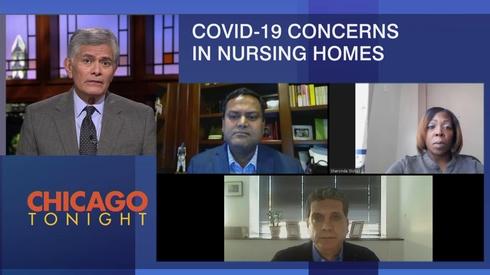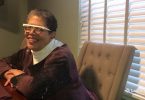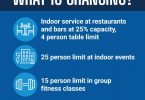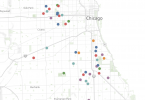https://news.wttw.com/2020/04/21/what-s-being-done-address-covid-19-nursing-homes-illinois
The statistics are sobering. Data released Sunday shows that nearly a quarter of all COVID-19 deaths in Illinois are tied to nursing homes and long-term care facilities.
Gov. J.B. Pritzker is now defending the state’s actions regarding these facilities.
“We started talking about and dealing with the problem in nursing homes in early March. This is before we ever had a disaster proclamation in the state. And long before we ever had a stay-at-home order, we shut down visitation at nursing homes and began to do wellness checks of the personnel there,” Pritzker said Tuesday.
On Monday, Pritzker announced the state would send in the National Guard to conduct testing at long-term care facilities where there are no known coronavirus cases in order to prevent outbreaks.
Before that, some nursing home staff reported being sent off-site for testing.
Sharonda Stokes, a certified nursing assistant (CNA) at Symphony of South Shore, tested positive for COVID-19 one week ago.
“You can go through drive-thrus, show a [health care worker] badge, show your I.D. and you can get tested without any questions,” Stokes said. “The issue is the fact that if I am positive or if my test results are pending, I’m not available to be there to work.”
Stokes, who is also the SIEU Healthcare Illinois union steward at the Symphony of South Shore, estimates that Symphony of South Shore has 75 patients who’ve tested positive and only 25% of the staff currently working, a condition she calls unsafe.
“I don’t feel like it is safe because how can you possibly take care of the sick? If I have 25% of staff, that means dietary lines, housekeeping, that’s everybody in the building, not necessarily just my aides,” Stokes said. “But if on a regular day, I didn’t have five aides show up, how do you think I can do that?”
Pritzker recently announced the state would release COVID-19 data for long-term care facilities on a weekly basis. According to the first report, there are 1,860 cases and 286 deaths. But some advocates for people living in group settings say that number may not be accurate — and that the state could be doing better.
“Our real concern is that that data is not as up to date as possible. We know of a facility where there’ve been two deaths and somebody who tested positive. And on the website it says that nobody’s tested positive and there’s been no deaths,” said Barry Taylor, vice president of the civil rights team for Equip for Equality, an organization that protects the civil and human rights of people with disabilities. “So it needs to be updated as soon as possible we would think on a daily basis.”
Dr. Rajeev Kumar, who serves as the medical director at two suburban facilities which have cases of the coronavirus, isolated those patients before getting any guidance from the state.
“We moved all of the residents that were either symptomatic or had tested positive to a dedicated unit,” said Kumar, the medical director at Burgess Square Healthcare and Rehab Centre in Westmont and Plymouth Place in La Grange.
“I relied upon CDC and AMBA which is our medical directors’ national professional organization,” said Kumar, a geriatrician and a board member for AMDA, the national society of post-acute and long-term care medicine. “[We] kind of morphed those guidelines to suit the needs of our seniors in senior living communities. We’ve actually taken some steps that are beyond what had been recommended by CDC.”
The availability of personal protective equipment (PPE) is also an issue at nursing homes and long-term care facilities.
“The state … I believe they’re trying to do everything they can. But we don’t have everything we need,” Kumar said. “I checked with my nursing homes procurement person, and they tell me that they’re still paying 10 times what they were paying for PPE before the COVID pandemic started in our country. They’re not getting it directly from the state or the county. So I’m hoping that that’ll change and now that we have COVID in the building and that we are potentially a major outbreak waiting to happen that we will get the support we need.”
“I don’t think there’s ever going to probably be enough [PPE],” said Stokes. “If you’re doing everything adequately the way that CDC requires you to do it, you have to use a lot of equipment per resident every time you’re in contact. You can’t use the same equipment for the next person. Nor can I walk out that room with it. So yeah, I’m going to use a lot of stuff and I’m going to need it. But right now it’s not even available.”
Staffing is also an issue at these facilities, where workers are either testing positive or too scared to come to work.
“When it first hit our building, a lot of people didn’t want to work cause they were scared there. Their main scare is not necessarily them catching it as it is going home to their kids or their parents or their grandparents. So it’s not even a fact of us facing that battle,” said Stokes. “It’s me going home and I might affect somebody or might possibly kill the next person.”
Illinois pledged to send in “strike teams” to help these facilities deal with COVID-19 outbreaks including doctors, nurses and public health officials. Those teams are conducting testing, doing facility reviews to check for necessary equipment and PPE and quarantining or isolating those who are positive. Advocates think the state can do more.
“Michigan is setting up these regional hubs where you get a facility that is designated for care of nursing home residents who have either been exposed to or have been tested positive for COVID-19 and that gives them the care that they need, but it also gets them out of the congregate living facility and the nursing home and allows people to more easily social distance and not have those infected with those who had not been infected,” said Taylor.







